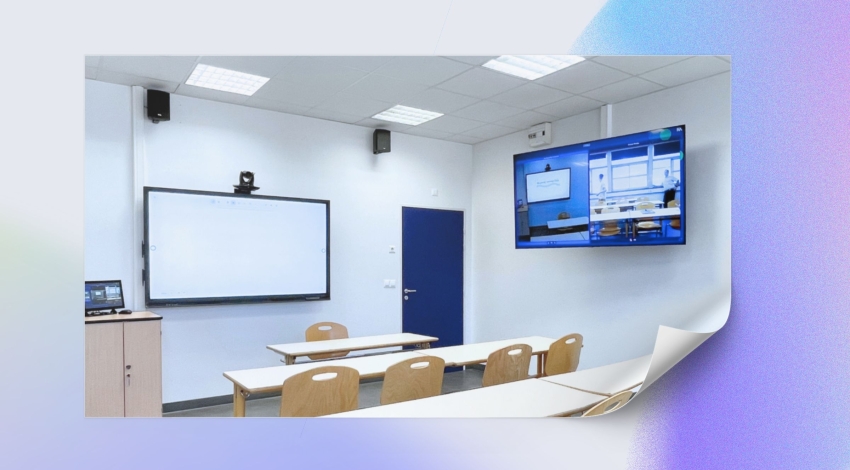

The era of digital teaching has revolutionized the way classrooms are designed, necessitating appropriate hybrid classroom equipment. This article explores the key components for creating an optimal blended learning environment.
By hybrid course, we mean a mix of face-to-face and remote learning. Some learners are in the classroom with the instructor, while others follow the course remotely, from their computers or from another campus, for example.
In a room that facilitates hybrid courses, a high-quality audiovisual system is crucial. It includes HD conference cameras, ceiling microphones for clear audio capture, and an interactive projector or touchscreen for dynamic visual presentation. Integrated speakers and audio amplifiers enhance the auditory experience.
The sound system is crucial in a hybrid classroom setup. It ensures that communications are clear and intelligible, both for participants in the room and those at a distance. If your budget allows, opt without hesitation for a ceiling tile microphone system, which will faithfully capture voices throughout the room while reducing background noise. Its positioning should be strategic: in the center of the room or above areas where speakers are likely to move, to effectively capture sound without echo or distortion.
Whatever your choice in terms of microphones, it is important to add echo cancellation technology. This helps eliminate unwanted reverberations and sound interference, ensuring a clear and delay-free sound transmission. As for the speakers, place them strategically for even sound distribution throughout the room. Consult your integrator for more information.
In the arsenal of hybrid classroom equipment, we recommend installing a sophisticated capture system equipped with PTZ (Pan-Tilt-Zoom) cameras, which offer unparalleled flexibility and precision in video capture.
The first camera should be strategically positioned at the back of the room. This placement is essential to capture all the instructor's movements. The camera's field of view should be wide enough to encompass all areas the instructor might move to, ensuring that remote learners have a complete and detailed view of the educational activities.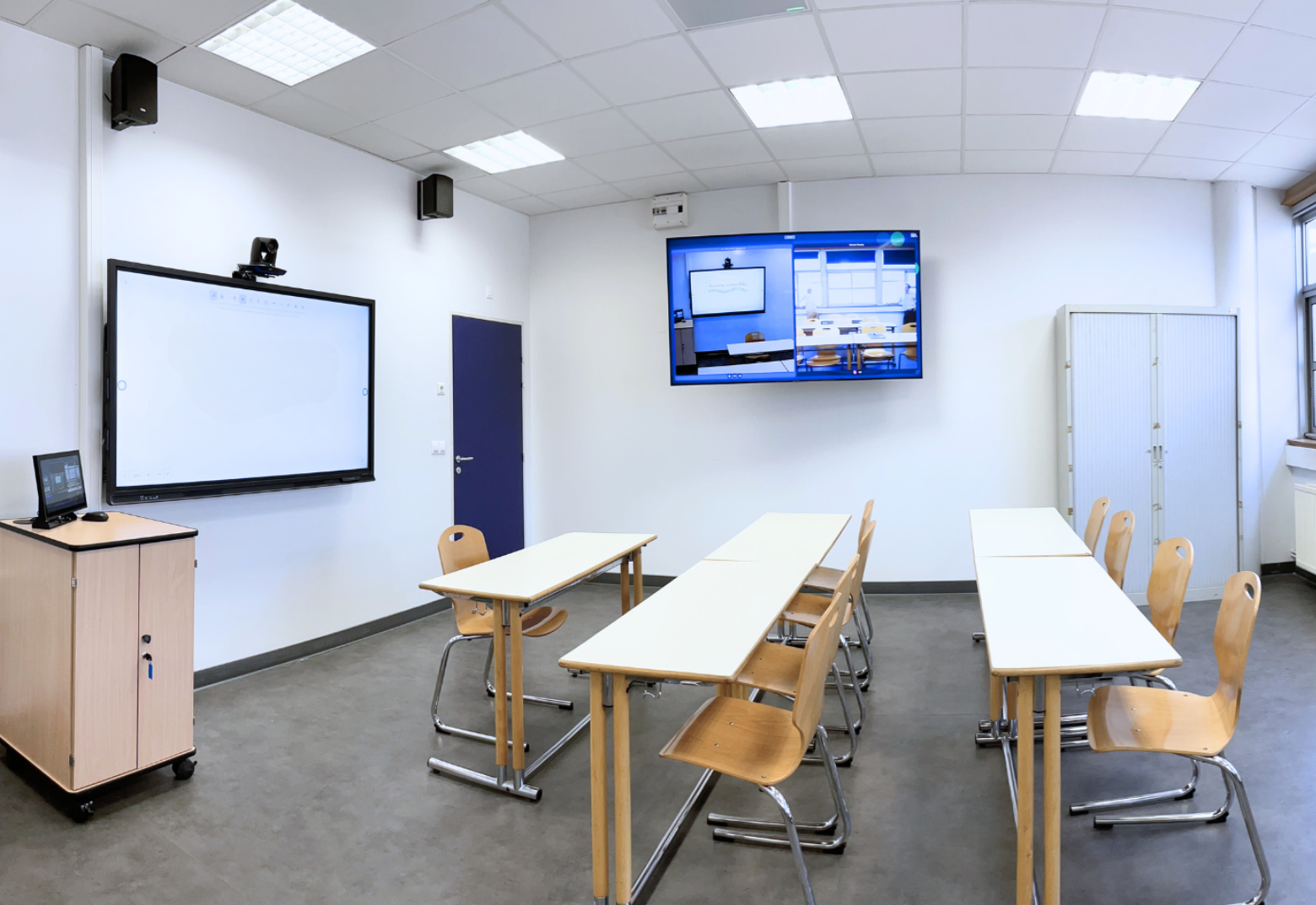
For optimal use, installing a simple control monitor in the room is advisable. This screen allows the instructor or a technician to adjust the camera’s zoom and orientation in real-time, based on the specific needs of the course and the instructor’s habits. This flexibility ensures that the vision for remote learners is always optimized, for an immersive learning experience.
Additionally, a second camera can be installed at the front of the room. This camera is intended to film all the participants present, capturing the group's interactions and reactions. This overview enriches the experience for remote learners, allowing them to feel more involved and connected with the classroom environment.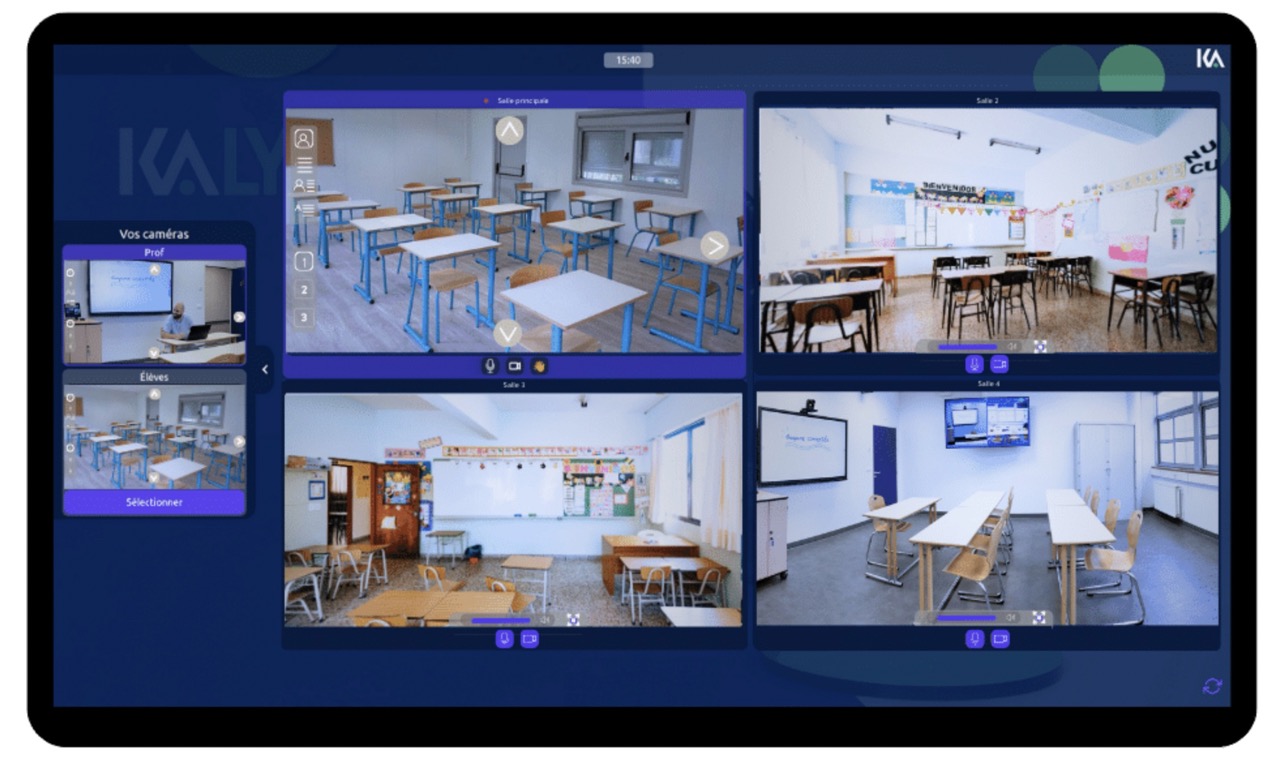
To transmit more technical or precise elements, such as non-digital documents or schematics, specific demonstrations of gestures, adding a table visualizer to the hybrid classroom equipment is worth considering. This device allows capturing high-definition images of physical objects or documents, and broadcasting them in real-time to learners, whether they are present in the room or connected remotely.
The table visualizer, also known as a document camera, is an extremely versatile tool in an educational context. It allows the instructor to show fine details that would not be visible via a standard PTZ camera. For instance, when presenting a complex diagram, conducting a scientific experiment, or demonstrating manual techniques, the visualizer provides a clear and precise view. The images captured by this visualizer can also be displayed in the room, for better visibility of in-person learners as well.
Hybrid classroom equipment should facilitate collaboration. Tools such as interactive whiteboards and screen-sharing software enable real-time interaction, essential in a blended learning environment. Integrated video conferencing systems allow seamless connection with remote participants.
Remote learners must be able to collaborate and interact with the teaching. For this, various tools and equipment can be set up.
Transitioning from Traditional Boards to Interactive Screens As part of your room renovations for an optimal comodal experience, it is crucial to modernize presentation and communication tools. Replacing the traditional board with an interactive screen is a significant step in this process. These interactive screens (or interactive projectors), offer your learners, whether remote or in-person, a much more qualitative experience.
These devices, connected to the room management system, allow real-time broadcasting of annotations and course content to remote students. Using an interactive screen not only makes it easier for learners to read the materials but also makes the sessions more engaging and interactive, for both those in the room and those participating remotely.
To go further, Kalyzée proposes integrating into your Android interactive whiteboard a collaborative shared whiteboard, which can be used both by the instructor and by remote learners who can collaborate live!
Using Interactive Educational Tools In the era of digital education, interactivity is key to engaging learners. Collaborating with instructors and educational engineers to compile a list of interactive tools is essential. Surveys, questionnaires, multiple-choice questions... each tool has the potential to transform a traditional course into a dynamic learning experience. Technology monitoring is necessary to determine which tools will be natively integrated into your educational environment. It is also crucial to define a budget for the integration and implementation of these tools. This strategic planning ensures that hybrid teaching is both interactive and economically viable.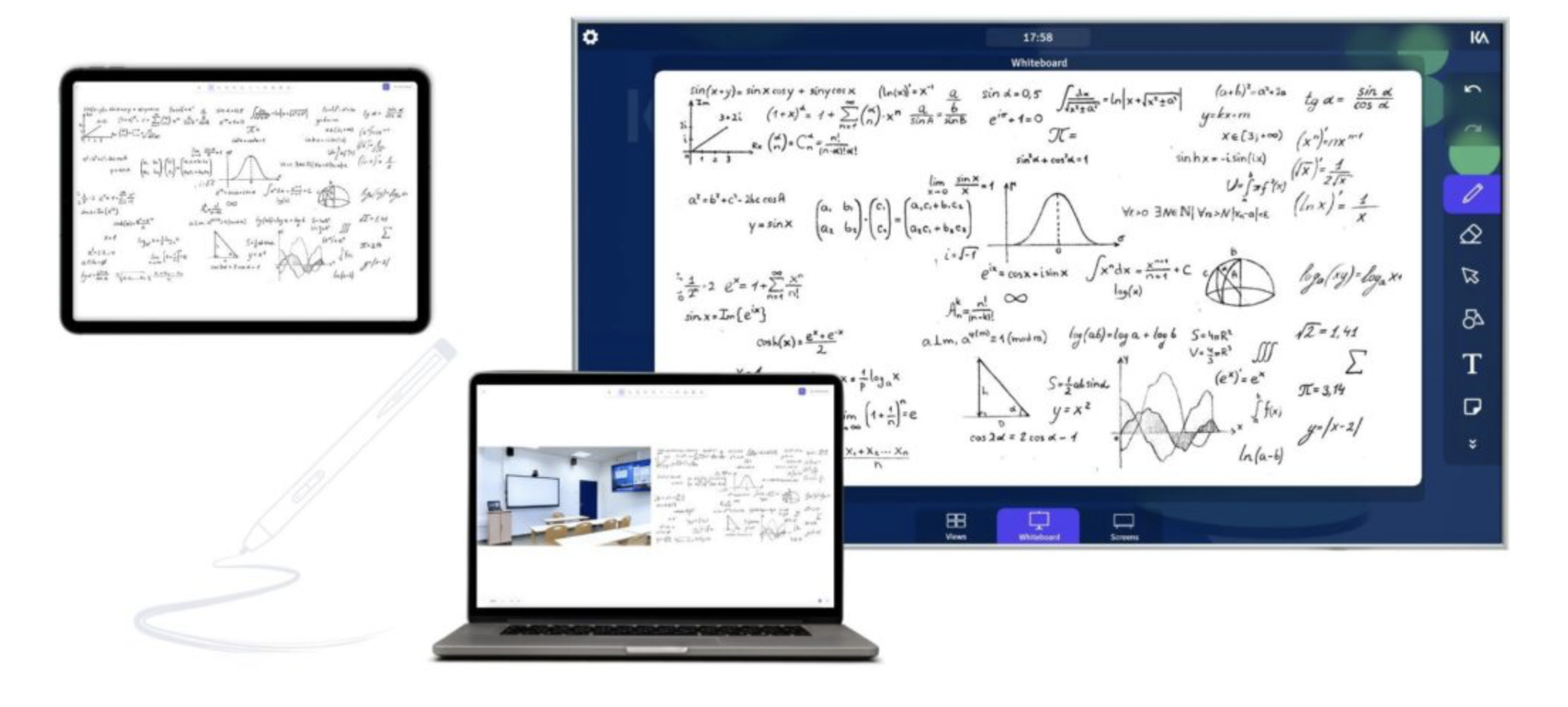
Communication is vital, especially in distance learning. Isolation and lack of communication are major challenges for remote learners. To address this, optimize your hybrid room infrastructure from the start. During classes, it is important that remote learners can interact as if they were physically present in the room. Integrating a chat system is a good start, but go further by planning a return screen. This screen will display remote learners wishing to activate their camera, thus facilitating a more personal and direct connection with the class. This screen creates a real sense of presence and fosters a sense of belonging, essential for an immersive and interactive learning experience.
The key to an effective hybrid training room lies in a robust internet connection and reliable network infrastructures. Whatever your choice in terms of communication, whether for live streaming or video conferencing, a solid infrastructure is indispensable. High-speed Wi-Fi combined with reliable network cabling is essential to maintain flawless connectivity and ensure smooth data transmission.
However, it is important to note that even in areas disadvantaged in terms of connectivity, innovative solutions exist. Take, for example, Kalyzée in 2023, which met the challenge of setting up interconnected hybrid rooms in the heart of the Amazon. Faced with limited connectivity in this area, a satellite link was established, overcoming the obstacle of low bandwidth. The live streaming systems were specially adapted to work efficiently under these conditions. The result? Comodal classrooms that today broadcast live classes from one college to four other villages.
This example perfectly illustrates how advanced and creative technological solutions can overcome connectivity challenges, thus opening doors to education in previously inaccessible regions. At Kalyzée, we firmly believe that every institution, no matter its geographical location, can benefit from quality hybrid training infrastructure.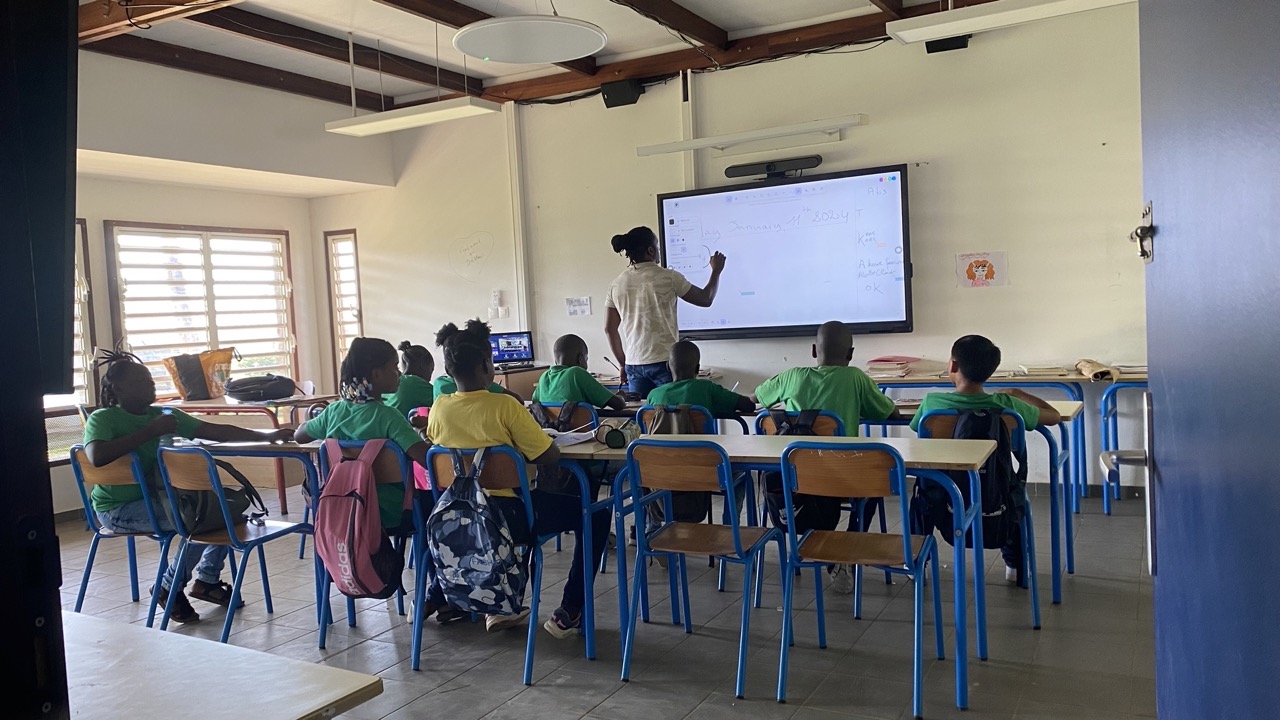
One of the pillars of modern education rests on the flexible arrangement of training spaces. For decades, institutions have adhered to standards that are now being modernized in response to the evolution of learning. In this dynamic, attention is increasingly focused on creating spaces that promote both comfort and adaptability.
Renovations of educational buildings widely incorporate principles of flexibility, with adjustable and modular furniture. This approach not only adapts to the varied needs of instructors and learners but also encourages a more dynamic and interactive pedagogy. From ergonomic chairs to modular desks, each element is designed to foster an active and collaborative workspace.
Whether you wish to build or simply renovate, it is important to consider all future uses of your rooms. This means anticipating the various configurations needed for the different types of courses, workshops, or seminars that will take place there. For example, a room intended for interactive online courses will require a different layout than one for group work sessions.
This is an essential question that will guide the choice of furniture and arrangement. Should the room allow easy collaborative work? Should it adapt to theoretical training sessions or practical work? These considerations should guide the design of the space to effectively meet the varied needs of hybrid teaching.
This question is just as crucial. The arrangement of a hybrid room must take into account not only current needs but also the potential evolution of teaching methods. For example, the integration of technologies like the interactive whiteboard or projector will require sufficient space for optimal use, while still maintaining flexibility for other pedagogical activities.
In summary, the equipment and arrangement of a hybrid training room must be designed to encourage pedagogical innovation, while remaining flexible enough to adapt to future evolutions in teaching.
In the modern era of education, the importance of accessibility cannot be understated, particularly in hybrid training rooms. Ensuring the integration of accessibility solutions suitable for all learners is not only a necessity but also a commitment to inclusive and equitable education. This approach involves the implementation of digital educational tools designed to meet the varied needs of learners, including those with special needs.
This could mean integrating screen reading software for the visually impaired, captioning and transcription for the hearing impaired, or adaptive interfaces for students with motor difficulties. Similarly, digital educational content must be designed in an accessible format, with clear visual elements, readable texts, and intuitive user interfaces.
Beyond compliance with accessibility standards, these digital tools must be flexible and customizable, so that teachers can adapt according to the specific needs of their students. For example, options to adjust the size and contrast of texts, or simplified interactive features, can greatly enhance the learning experience for some learners.
Integrating these accessibility solutions into hybrid training rooms is not just a matter of technology, but also of pedagogy. It requires a deep understanding of the various ways students interact with digital content and an ongoing commitment to ensure that every learner has equal learning opportunities.
Data security and the protection of equipment are crucial components in the layout of a hybrid training room. Implementing a secure access control system is fundamental to ensuring the safety of equipment and sensitive information. This system allows regulating who can access the room and its equipment, thereby reducing the risk of theft or sabotage.
Regarding data management, it is strongly advised to use French or European solutions, if possible, to comply with the strict standards of the European Union regarding data protection. These standards, such as the General Data Protection Regulation (GDPR), ensure responsible management and use of personal data, particularly relevant in the context of teaching and training.
Moreover, a robust data backup infrastructure is very important to prevent the loss of critical information. Indeed, it is essential to ensure that all educational data, whether student works, course materials, but especially the personal data of learners, are securely stored and easily recoverable in case of an incident.
It is also important to highlight the existence of a dynamic edtech ecosystem, where all solutions related to technology in the education sector are listed. This ecosystem offers a variety of resources and tools, allowing educational institutions to find technological solutions tailored to their specific needs, while respecting security and confidentiality standards.
The successful integration of sophisticated hybrid room equipment relies on an often-overlooked but essential element: adequate training of staff and teachers. Experience shows that one of the main barriers to successful adoption of technology in teaching is not so much the technology itself, but the lack of preparation and involvement of the end-users – particularly the instructors.
Too often, instructors find themselves with tools they neither chose nor requested, making the digital transition more difficult. To avoid this pitfall, it is crucial to involve instructors and other stakeholders from the early stages of the project. This not only ensures that the selected tools meet their actual needs but also familiarizes them with these technologies from the start.
Adequate training must cover not only the technical aspects of using the equipment but also the best pedagogical practices to maximize their potential in a hybrid learning environment. This could include workshops on the effective use of interactive tools, sessions on strategies for engaging remote students, and training on managing virtual classrooms.
Additionally, ongoing technical support is another essential pillar. It is not enough to have cutting-edge equipment; it is also necessary to provide quick and effective technical support to resolve any issues that may arise. This involves having a dedicated technical support team, capable of intervening promptly to minimize disruptions and maintain a smooth and effective learning environment.
Are you considering modernizing your training room to integrate comodality? Look no further, contact us at Kalyzée! With over 10 years of experience, we specialize in designing audiovisual solutions dedicated to learning. At Kalyzée, we go beyond simple technical solutions: we offer tailor-made business solutions, perfectly adapted to your requirements and educational environment.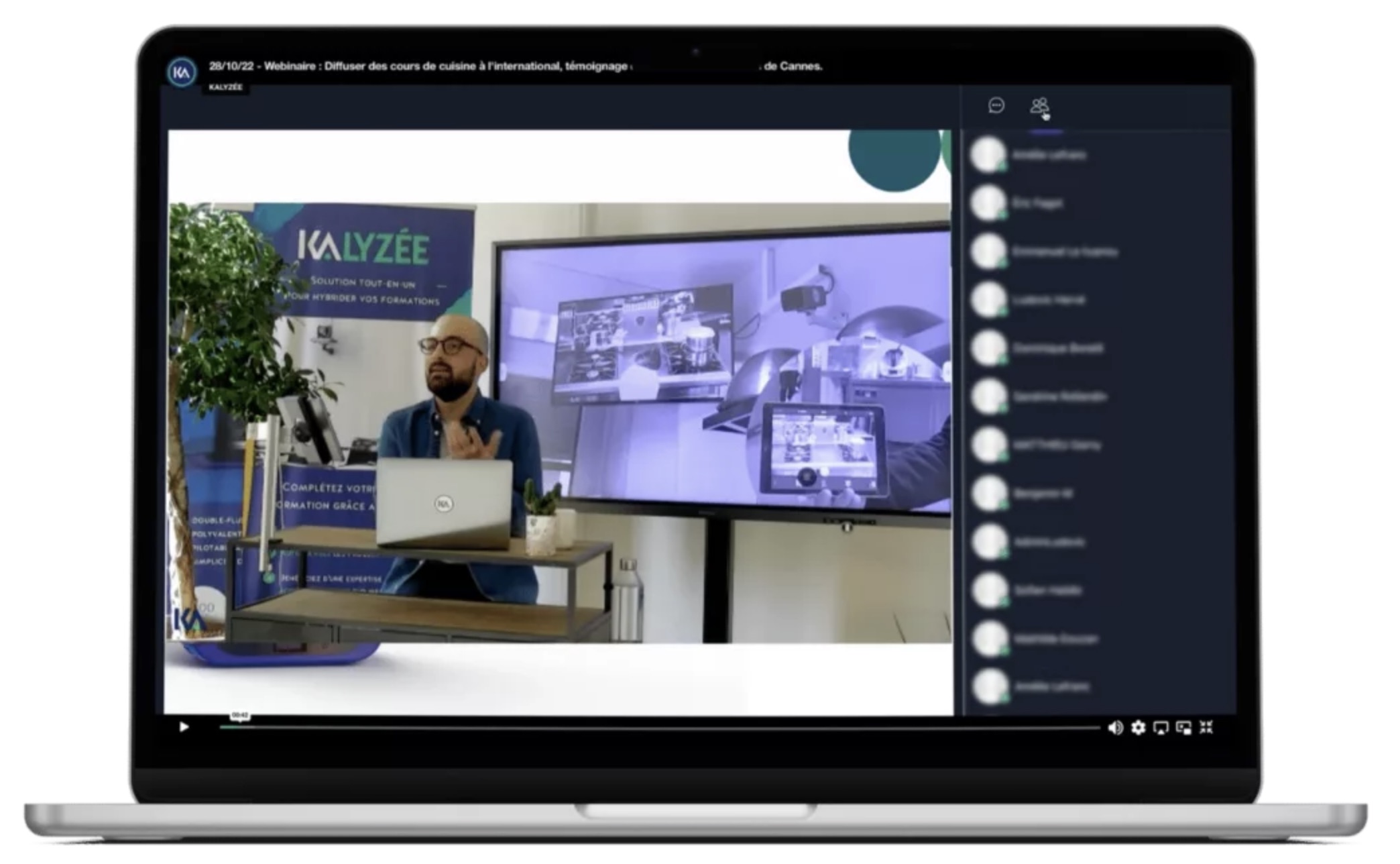
Our process begins with a detailed analysis of your needs. We understand that each project is unique, and our goal is to reflect this uniqueness in our approach. Once your needs and objectives are clearly defined, we accompany you at every step of the implementation of your project.
This includes drafting a comprehensive specification, developing specific solutions adapted to your context, integrating and automating the course publication processes, and sourcing the most suitable equipment for your project. We also provide a detailed installation synoptic to be handed over to your integrator.
Moreover, we assist you in choosing your integrator, ensuring that the material setup of your project proceeds smoothly. Finally, we provide you with the most suitable communication system for your needs, ensuring that your hybrid training room is not only equipped with the best technologies but also perfectly aligned with your pedagogical methods.
With Kalyzée, transforming your training space into a cutting-edge comodal environment is not only possible but also smooth and tailor-made. Contact us today to begin your journey towards innovative and interactive education!